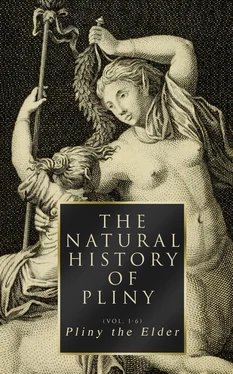Similarly circumstanced, but by no means equal in size and in power, next to it, is the star Mercury, by some called Apollo 158; it is carried in a lower orbit, and moves in a course which is quicker by nine days, shining sometimes before the rising of the sun, and at other times after its setting, but never going farther from it than 23 degrees 159, as we learn from Timæus and Sosigenes 160. The nature of these two stars is peculiar, and is not the same with those mentioned above, for those are seen to recede from the sun through one-third or one-fourth part of the heavens, and are often seen opposite to it. They have also other larger circuits, in which they make their complete revolutions, as will be described in the account of the great year 161.
(9.) But the Moon 162, which is the last of the stars, and the one the most connected with the earth, the remedy provided by nature for darkness, excels all the others in its admirable qualities. By the variety of appearances which it assumes, it puzzles the observers, mortified that they should be the most ignorant concerning that star which is the nearest to them. She is always either waxing or waning; sometimes her disc is curved into horns, sometimes it is divided into two equal portions, and at other times it is swelled out into a full orb; sometimes she appears spotted 163and suddenly becomes very bright; she appears very large with her full orb and suddenly becomes invisible; now continuing during all the night, now rising late, and now aiding the light of the sun during a part of the day; becoming eclipsed and yet being visible while she is eclipsed; concealing herself at the end of the month and yet not supposed to be eclipsed 164. Sometimes she is low down, sometimes she is high up, and that not according to one uniform course, being at one time raised up to the heavens, at other times almost contiguous to the mountains; now elevated in the north, now depressed in the south; all which circumstances having been noticed by Endymion, a report was spread about, that he was in love with the moon 165. We are not indeed sufficiently grateful to those, who, with so much labour and care, have enlightened us with this light 166; while, so diseased is the human mind, that we take pleasure in writing the annals of blood and slaughter, in order that the crimes of men may be made known to those who are ignorant of the constitution of the world itself.
Being nearest to the axis 167, and therefore having the smallest orbit, the Moon passes in twenty-seven days and the one-third part of a day 168, through the same space for which Saturn, the highest of the planets, as was stated above, requires thirty years. After remaining for two days in conjunction with the sun, on the thirtieth day she again very slowly emerges to pursue her accustomed course 169. I know not whether she ought not to be considered as our instructress in everything that can be known respecting the heavens; as that the year is divided into the twelve divisions of the months, since she follows the sun for the same number of times, until he returns to the commencement of his course; and that her brightness, as well as that of the other stars, is regulated by that of the sun, if indeed they all of them shine by light borrowed from him, such as we see floating about, when it is reflected from the surface of water. On this account it is that she dissolves so much moisture, by a gentle and less perfect force, and adds to the quantity of that which the rays of the sun consume 170. On this account she appears with an unequal light, because being full only when she is in opposition, on all the remaining days she shows only so much of herself to the earth as she receives light from the sun 171. She is not seen in conjunction, because, at that time, she sends back the whole stream of light to the source whence she has derived it. That the stars generally are nourished by the terrestrial moisture is evident, because, when the moon is only half visible she is sometimes seen spotted, her power of absorbing moisture not having been powerful enough; for the spots are nothing else than the dregs of the earth drawn up along with the moisture 172. (10.) But her eclipses and those of the sun, the most wonderful of all the phenomena of nature, and which are like prodigies, serve to indicate the magnitude of these bodies and the shadow 173which they cast.
CHAP. 7.—OF THE ECLIPSES OF THE MOON AND THE SUN.
Table of Contents
For it is evident that the sun is hid by the intervention 174of the moon, and the moon by the opposition 174of the earth, and that these changes are mutual, the moon, by her interposition 174, taking the rays of the sun from the earth, and the earth from the moon. As she advances darkness is suddenly produced, and again the sun is obscured by her shade; for night is nothing more than the shade of the earth. The figure of this shade is like that of a pyramid or an inverted top 175; and the moon enters it only near its point, and it does not exceed the height of the moon, for there is no other star which is obscured in the same manner, while a figure of this kind always terminates in a point. The flight of birds, when very lofty, shows that shadows do not extend beyond a certain distance; their limit appears to be the termination of the air and the commencement of the æther. Above the moon everything is pure and full of an eternal light. The stars are visible to us in the night, in the same way that other luminous bodies are seen in the dark. It is from these causes that the moon is eclipsed during the night 176. The two kinds of eclipses are not, however, at the stated monthly periods, on account of the obliquity of the zodiac, and the irregularly wandering course of the moon, as stated above; besides that the motions of these stars do not always occur exactly at the same points 177.
CHAP. 8. (11.)—OF THE MAGNITUDE OF THE STARS.
Table of Contents
This kind of reasoning carries the human mind to the heavens, and by contemplating the world as it were from thence, it discloses to us the magnitude of the three greatest bodies in nature 178. For the sun could not be entirely concealed from the earth, by the intervention of the moon, if the earth were greater than the moon 179. And the vast size of the third body, the sun, is manifest from that of the other two, so that it is not necessary to scrutinize its size, by arguing from its visible appearance, or from any conjectures of the mind; it must be immense, because the shadows of rows of trees, extending for any number of miles, are disposed in right lines 180, as if the sun were in the middle of space. Also, because, at the equinox, he is vertical to all the inhabitants of the southern districts at the same time 181; also, because the shadows of all the people who live on this side of the tropic fall, at noon, towards the north, and, at sunrise, point to the west. But this could not be the case unless the sun were much greater than the earth; nor, unless it much exceeded Mount Ida in breadth, could he be seen when he rises, passing considerably beyond it to the right and to the left, especially, considering that it is separated by so great an interval 182.
The eclipse of the moon affords an undoubted argument of the sun’s magnitude, as it also does of the small size of the earth 183. For there are shadows of three figures, and it is evident, that if the body which produces the shadow be equal to the light, then it will be thrown off in the form of a pillar, and have no termination. If the body be greater than the light, the shadow will be in the form of an inverted cone 184the bottom being the narrowest part, and being, at the same time, of an infinite length. If the body be less than the light, then we shall have the figure of a pyramid 185, terminating in a point. Now of this last kind is the shadow which produces the eclipse of the moon, and this is so manifest that there can be no doubt remaining, that the earth is exceeded in magnitude by the sun, a circumstance which is indeed indicated by the silent declaration of nature herself. For why does he recede from us at the winter half of the year 186? That by the darkness of the nights the earth may be refreshed, which otherwise would be burned up, as indeed it is in certain parts; so great is his size.
Читать дальше












